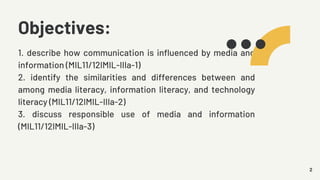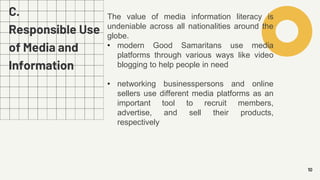Module 1 Lesson 1.pptx
- 1. INTRODUCTION TO MEDIA AND INFORMATION LITERACY 01 Module 1 | Lesson 1
- 2. Objectives: 2 1. describe how communication is influenced by media and information (MIL11/12IMIL-IIIa-1) 2. identify the similarities and differences between and among media literacy, information literacy, and technology literacy (MIL11/12IMIL-IIIa-2) 3. discuss responsible use of media and information (MIL11/12IMIL-IIIa-3)
- 3. 3 In the present time, technological advancement is inevitable, and the access of information is very much available with the aid of technology. Media and Information Literacy accentuate an individual's capability to exercise his/her fundamental human rights, specifically the right to express his/her opinion using any kind of media platform and the right to access information responsibly.
- 4. 4 Media and Information Literacy involves necessary skills that let a person interact using different media platforms and get access to information around the globe. Media and its significant role in our society: • disseminating information, • connecting people, and • acting as an agent of change in our society.
- 5. A. Communication and Media Information 5 Communication is affected by media and information because of the advancement of technology and the availability of different communication services. However, this form of communication may have a negative effect on people in terms of personal relationships that may be strained by the over-reliance on social media that are fertile grounds for fake news and hoaxes.
- 6. A. Communication and Media Information 6 Therefore, we should always be mindful in taking advantage of the use of communication technology in appropriate ways. We must keep in mind the principle of “Think before you click”.
- 7. B. Media Literacy, Information Literacy, and Technology Literacy 7 Media literacy highlights the capacity of an individual to understand the functions of media and determine the relevant use and worth of media platforms. Information literacy is the communication or acquiring of data or facts that relate to the use of media information.
- 8. B. Media Literacy, Information Literacy, and Technology Literacy 8 Technology literacy, on the other hand, is the skill of an individual to manipulate technology independently in an efficient and suitable way. These skills are needed to access knowledge and communicate information in a legal and ethical manner. Information and media literacy enable people to become a responsible user and producer of media and information.
- 9. C. Responsible Use of Media and Information 9 The 21st Century is known as the information age. Now, people are highly dependent on technology in different aspects of their lives such as for communication, entertainment, and work-related activities. Responsible use of media and information is encouraged especially in education.
- 10. C. Responsible Use of Media and Information 10 The value of media information literacy is undeniable across all nationalities around the globe. • modern Good Samaritans use media platforms through various ways like video blogging to help people in need • networking businesspersons and online sellers use different media platforms as an important tool to recruit members, advertise, and sell their products, respectively
- 11. C. Responsible Use of Media and Information 11 Some social media are agents of change. • increase awareness or elicit public response There is, at present, little guarantee on the truth of what is being shared, but people react to it. We have to make sure that the information we share are factual and come from reliable sources. The ease of getting information via media also has its disadvantage: the risk of invasion of privacy.
- 12. C. Responsible Use of Media and Information 12 Tips for the responsible use of media and information. 1. Ensure personal information safety – Do not display or give away your personal information on your social media account. When you are using applications and websites, read first the “terms of use”. 2. Get permission – When posting videos or pictures of other people on your social media account, do not forget to ask for the owner's approval and of the people who appeared in the video or picture. 3. Think before you click – When posting or sharing on social media, think first if the information you are going to post or share is accurate, helpful, informative, nice, and kind to others.
- 13. C. Responsible Use of Media and Information 13 Tips for the responsible use of media and information. 4. Keep your password safe – Keep an eye on your account; do not let others know your password. Update your password often to avoid your account from being hacked or used by a poser. 5. Spread positivity – Share positive and uplifting posts to your friends. As much as possible, avoid negativity and hate in your account because what you post on social media becomes a reflection of yourself.
- 14. 14 In a piece of paper, write your analysis of the editorial cartoon shown below. How are you going to relate this to responsible use of media and information in a democratic society? Activity: Editorial Cartoon Analysis
- 15. Prepared By: 15 Listher Vic Z. Beltran Teacher i Guadalupe National High S chool
- 16. Thank you! 16















